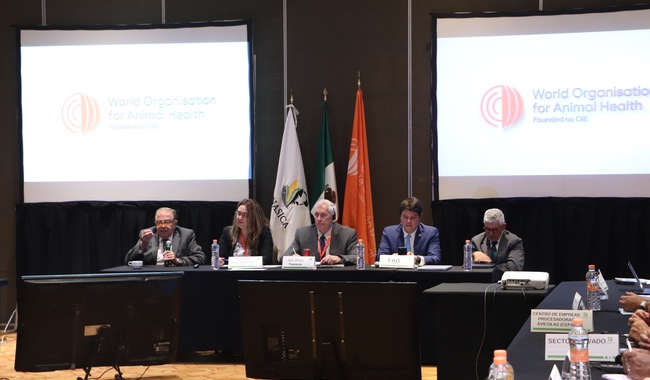In order to face global threats, such as the highly pathogenic avian influenza (HPAI) AH5N1, experts and high-level officials in animal health and industry representatives from 32 countries in the Americas endorsed their commitment to advance in the mapping of the main wildlife diseases in the region and strengthen technical, scientific and diagnostic collaboration.
In a five-day meeting, they also recommended periodic vaccination of long-lived and breeding birds, in order to protect food safety, commercial activity and the assets of producers, which should be considered as a complementary tool in the strategy to control HPAI AH5N1 outbreaks that have occurred in much of the continent since 2021.
They stressed that each country should be responsible for applying efficient biologicals that demonstrate protection against the current strain of HPAI HPAI AH5N1, provided that there is adequate epidemiological surveillance to verify the absence of the disease in inoculated animals and the inability to infect other birds.
The international representatives shared technical knowledge and experiences in Mexico City, where the Regional Workshop for Delegates and National Focal Points for Wildlife of the World Organization for Animal Health (OMSA, by its Spanish acronym) for the Americas and the Second Meeting of the Permanent Group of Experts on Avian Influenza of the Global Transboundary Animal Diseases Program (GF-TADs) for the Americas were held.
During the meeting, the chief director of the National Service for Agrifood Health, Safety and Quality (Senasica), Javier Calderón Elizalde, stressed that for the Mexican Government it is an honor that the OMSA has chosen our country as the venue for two meetings of specialists of the continent, which are of great relevance because it is about finding coordinated solutions to issues of common concern, such as diseases of wild animals and in particular, highly pathogenic avian influenza.
He indicated that diseases do not respect borders, so it is important that the countries of the region seek common strategies to advance the work carried out by health agencies around the concept of One Health, promoted by the United Nations (ONU, by its Spanish acronym).
We are linking, he said, the international will to undertake regional efforts to better protect wildlife, commercial and family poultry farming and, consequently, the health of the population.
He stressed that Mexico is the world's sixth largest producer of poultry meat and eggs for dishes, with a production of 3.6 and 3.4 million tons per year, respectively, so it is a priority to have a strong and stable poultry production, capable of generating employment and development for rural communities and ensuring healthy and safe products at affordable prices for the population.
Senasica's General Director of Animal Health, Juan Gay Gutiérrez, pointed out that the HPAI H5N1 outbreak that has affected dozens of countries in America, Europe, Africa and Asia represents a watershed for the world veterinary services, since, for the first time since records have been kept, migratory birds have spread the disease from the extreme northern hemisphere to the south, which has led to the slaughter of more than 100 million poultry in the world.
He added that this meeting comes at the right time, since among the challenges to be discussed is the need to change the paradigm of integrating the vaccination of priority birds without alterations in the trade of the countries.
The representative in Mexico of the Food and Agriculture Organization of the United Nations (FAO), Eduardo Benítez Paulin, emphasized that the evolution of animal diseases represents a high risk for the balance of ecosystems, so it is the obligation of health authorities to take action and apply coordinated actions.
At FAO we are sure that this type of technical meetings will lead us to make better decisions in the short, medium and long term, he said.
Senasica's Director of Livestock Services and Certification, María Elena González Ruiz, pointed out that in order to provide the national production sector with effective emergency vaccines against HPAI H5N1, Senasica invited the pharmaceutical industry to develop optimal chemical engineering biologics, which, before being authorized, underwent a series of tests in the high-security laboratories of the Ministry of Agriculture's agency.
After presenting to international representatives the details of the National Animal Health Emergency Device (Dinesa) that Agriculture operated to protect the national poultry heritage, the director of the Mexico-United States Commission for the Prevention of Foot and Mouth Disease and other Exotic Animal Diseases (CPA, by its Spanish) of Senasica, Roberto Navarro Lopez, led a round table to discuss the strategy for the use of emergency vaccines against the disease.
He specified that the Agriculture agency prioritized the selective application of 198 million vaccines to breeding birds, long-lived birds, birds in focal zones, backyard birds and finally to birds in zoos, with the support of more than 500 authorized responsible veterinarians (MVRA, by its Spanish acronym).
The meetings were attended by delegates, focal points and representatives of the poultry industry from Antigua and Barbuda, Argentina, Barbados, Belize, Bolivia, Brazil, Canada, Colombia, Costa Rica, Cuba, Curacao, Chile, Dominican Republic, Ecuador, El Salvador, Guatemala, Guyana, Haiti, Honduras, Jamaica, Mexico, Nicaragua, Panama, Paraguay, Peru, United Kingdom, United States, St. Vincent and the Grenadines, Suriname, Trinidad and Tobago, Uruguay and Venezuela.
Among the topics discussed during the sessions were: the main wildlife diseases in the Americas and their management, an update on the epidemiological situation of HPAI AH5N1 outbreaks at the global and regional levels, commercial and backyard poultry farming and recommendations for the development of policies for the prevention, control and eradication of the disease, among o
